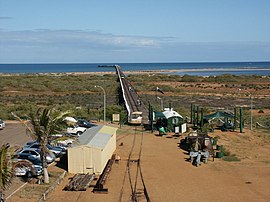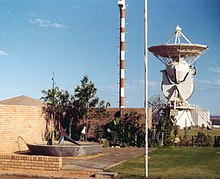Carnarvon, Western Australia: Difference between revisions
→Climate: it's not the *absolute* highest; Roebourne also recorded this figure |
TheQ Editor (talk | contribs) m Repairing 1 and tagging 1 external links using Checklinks |
||
| Line 31: | Line 31: | ||
| location3= [[Karratha, Western Australia|Karratha]] |
| location3= [[Karratha, Western Australia|Karratha]] |
||
}} |
}} |
||
'''Carnarvon''' is a coastal town situated approximately 900 kilometres north of [[Perth, Western Australia|Perth]], [[Western Australia]]. It lies at the mouth of the [[Gascoyne River]] on the [[Indian Ocean]]. The popular [[Shark Bay]] world heritage area lies to the south of the town and the [[Ningaloo Reef]] lies to the north. At the [[ |
'''Carnarvon''' is a coastal town situated approximately 900 kilometres north of [[Perth, Western Australia|Perth]], [[Western Australia]]. It lies at the mouth of the [[Gascoyne River]] on the [[Indian Ocean]]. The popular [[Shark Bay]] world heritage area lies to the south of the town and the [[Ningaloo Reef]] lies to the north. At the [[2011 Australian Census|2011 census]], Carnarvon had a population of 4,559.<ref name="ABS">{{Census 2011 AUS |
||
|id=UCL515005 |
|id=UCL515005 |
||
|name=Carnarvon (Urban Centre/Locality) |
|name=Carnarvon (Urban Centre/Locality) |
||
| Line 60: | Line 60: | ||
== Education == |
== Education == |
||
There are six schools in the town; one Catholic, four Western Australia Department of Education schools and one independent. These schools are: [[St Mary's Star of the Sea Catholic School]] which was built in 1906, [[Carnarvon Senior High School]], East Carnarvon Primary School [http://myweb.westnet.com |
There are six schools in the town; one Catholic, four Western Australia Department of Education schools and one independent. These schools are: [[St Mary's Star of the Sea Catholic School]] which was built in 1906, [[Carnarvon Senior High School]], East Carnarvon Primary School [http://myweb.westnet.com ], Carnarvon Primary School, Carnarvon School of the Air and Carnarvon Christian School. |
||
== Climate == |
== Climate == |
||
Revision as of 21:37, 29 April 2014
| Carnarvon Western Australia | |||||||||
|---|---|---|---|---|---|---|---|---|---|
 Carnarvon jetty | |||||||||
| Coordinates | 24°53′02″S 113°39′40″E / 24.884°S 113.661°E | ||||||||
| Population | 4,459 (2011 census)[1] | ||||||||
| Established | 1883 | ||||||||
| Postcode(s) | 6701 | ||||||||
| Elevation | 4 m (13 ft) | ||||||||
| Location | |||||||||
| LGA(s) | Shire of Carnarvon | ||||||||
| State electorate(s) | North West | ||||||||
| Federal division(s) | Durack | ||||||||
| |||||||||
Carnarvon is a coastal town situated approximately 900 kilometres north of Perth, Western Australia. It lies at the mouth of the Gascoyne River on the Indian Ocean. The popular Shark Bay world heritage area lies to the south of the town and the Ningaloo Reef lies to the north. At the 2011 census, Carnarvon had a population of 4,559.[1]
History
The town was founded in 1883, initially as a port and supply centre for the surrounding region, and is the administrative centre for the Shire of Carnarvon. The town site was officially gazetted on 4 June 1891, named after Henry Herbert, 4th Earl of Carnarvon, a past Secretary of State for the Colonies.
Carnarvon has had three tramways.[2]
- The first, shown on a Public Works Department map of 1884, ran from a landing site on the river, across Olivia Terrace to a shed on the other side of the road - A very short tramway indeed. The trolley used on this tramway was supposed to be hand powered, using a lever attached to crank on two of the wheels. However there is a reference to the use of wind-power.
- The second tramway, constructed between 1886 and 1887, ran west from Olivia Terrace in a straight line to the jetty, which was half way between Mangrove Point and Conspicuous Clump. It was horse drawn.
- The third, and partially remaining, tramway was completed on 9 November 1900. It runs from the townsite, across Babbage Island to the deep-sea jetty. It was constructed with a rail gauge of 2 feet (610 mm). It was 2 miles 5 chains (3.3 km) long. Due to the heavy loads of wool being carried on what was a very light railway, it was decided to convert the tramway to 3 feet 6 inches (1,067 mm) gauge in 1908–09. This tramway was worked with a steam locomotive. The tramway ceased operation in 1965.
The Carnarvon Light Railway Association now operates trains along restored tracks on the jetty.
In 2013 the town was menaced by a bushfire burning on the north eastern side of town. The fire burnt out of control with strong winds starting spot fires among the banana plantations.[3] The blaze was controlled a day later but destroyed 1,400 hectares (3,500 acres) of bushland, including 20 derelict buildings and sheds; the plantations only received minor damage.[4]
Economy
Main economic activities of the area include:
- mining, at a salt mine on nearby Lake Macleod and at inland mines.
- agriculture, particularly bananas (mainly cavendish bananas) and tomatoes, wool, cattle, sheep and goats.
- fishing (major focus is a prawn fishery), tourism.

During the 1960s, NASA set up a tracking station nearby to support the Gemini and Apollo space programs. The tracking station was closed in the mid-1970s. Only the foundations of what was an historical site remain. See also OTC Satellite Earth Station Carnarvon.
Radio Australia had a shortwave relay station (built during the 1970s) that used to relay programming to Europe, South Asia and Southeast Asia.
Education
There are six schools in the town; one Catholic, four Western Australia Department of Education schools and one independent. These schools are: St Mary's Star of the Sea Catholic School which was built in 1906, Carnarvon Senior High School, East Carnarvon Primary School [1], Carnarvon Primary School, Carnarvon School of the Air and Carnarvon Christian School.
Climate
Carnarvon has a warm semi-arid climate. Average yearly rainfall is 226 millimetres (8.90 in) with the rainiest months (and the most reliable rainfall) being between May and July. Occasional tropical cyclones affect Carnarvon during the summer months bringing heavy rain and strong winds. Apart from this erratic source of rainfall summers are normally dry. Temperatures range from an average maximum of 33 °C (91 °F) in February to 22 °C (72 °F) in July. Average minimums are 23 °C (73 °F) and 11 °C (52 °F) respectively. On 6 March 2007, Carnarvon equalled the record for Australia's hottest March temperature with a maximum of 47.8 °C (118.0 °F); this temperature had previously been recorded in the Western Australian town of Roebourne on 4 March 1998.[5]
| Climate data for Carnarvon | |||||||||||||
|---|---|---|---|---|---|---|---|---|---|---|---|---|---|
| Month | Jan | Feb | Mar | Apr | May | Jun | Jul | Aug | Sep | Oct | Nov | Dec | Year |
| Record high °C (°F) | 47.7 (117.9) |
46.9 (116.4) |
47.8 (118.0) |
41.1 (106.0) |
37.1 (98.8) |
31.8 (89.2) |
30.7 (87.3) |
31.6 (88.9) |
38.4 (101.1) |
42.4 (108.3) |
43.4 (110.1) |
45.4 (113.7) |
47.8 (118.0) |
| Mean daily maximum °C (°F) | 31.3 (88.3) |
32.5 (90.5) |
31.6 (88.9) |
29.1 (84.4) |
26.2 (79.2) |
23.4 (74.1) |
22.3 (72.1) |
23.0 (73.4) |
24.4 (75.9) |
26.0 (78.8) |
27.6 (81.7) |
29.3 (84.7) |
27.2 (81.0) |
| Mean daily minimum °C (°F) | 22.5 (72.5) |
23.4 (74.1) |
22.1 (71.8) |
19.1 (66.4) |
14.9 (58.8) |
12.3 (54.1) |
10.9 (51.6) |
11.6 (52.9) |
13.8 (56.8) |
16.4 (61.5) |
18.6 (65.5) |
20.6 (69.1) |
17.2 (63.0) |
| Record low °C (°F) | 15.9 (60.6) |
17.1 (62.8) |
13.2 (55.8) |
9.5 (49.1) |
6.1 (43.0) |
3.6 (38.5) |
2.4 (36.3) |
3.5 (38.3) |
5.9 (42.6) |
8.1 (46.6) |
10.7 (51.3) |
14.0 (57.2) |
2.4 (36.3) |
| Average rainfall mm (inches) | 12.3 (0.48) |
20.6 (0.81) |
16.2 (0.64) |
14.1 (0.56) |
35.2 (1.39) |
37.6 (1.48) |
45.3 (1.78) |
18.0 (0.71) |
5.6 (0.22) |
5.3 (0.21) |
4.1 (0.16) |
5.7 (0.22) |
220 (8.66) |
| Average rainy days (≥ 0.2mm) | 2.0 | 2.5 | 2.1 | 2.7 | 5.0 | 7.3 | 7.2 | 5.1 | 3.0 | 2.2 | 1.3 | 0.7 | 41.1 |
| Source: Bureau of Meteorology[6] | |||||||||||||
Rocketry
From 1964–1965, 12 sounding rockets were launched from Carnarvon to a maximum altitude of 120 km [2]
Korean Star
On 20 May 1988, the bulk carrier Korean Star ran aground in bad weather near Cape Cuvier, within the port limits of Carnarvon. Around 600 tonnes of fuel oil were spilled into the ocean. Damage was limited to 10 km of remote beaches and coastline. The ship was not salvaged and left grounded, however very little of the wreck remains to be seen.
December 2010 floods
See also
References
- ^ a b Australian Bureau of Statistics (31 October 2012). "Carnarvon (Urban Centre/Locality)". 2011 Census QuickStats. Retrieved 28 April 2013.
- ^ Rogers, Phillipa. Carnarvon's Tramways: A History Australian Railway Historical Society Bulletin, August, 1999 pp. 296–307
- ^ "Crews fight blaze threatening Carnarvon plantations". Australian Broadcasting Corporation. 28 January 2013. Retrieved 27 March 2013.
- ^ "Firefighters shore up Carnarvon containment lines". Australian Broadcasting Corporation. 29 January 2013. Retrieved 27 March 2013.
- ^ Bureau of Meteorology (21 March 2013). "Daily Extremes". Australian daily extremes tables. Commonwealth of Australia. Retrieved 29 April 2014.
- ^ "Carnarvon Airport". Climate statistics for Australian locations. Bureau of Meteorology. April 2013. Retrieved 13 April 2013.
External links
- Shire of Carnarvon
- Australian Places - Carnarvon
- Carnarvon Flood Photos 2010 - ABC Last accessed 22 December 2010

